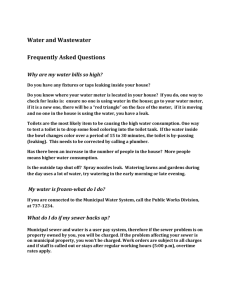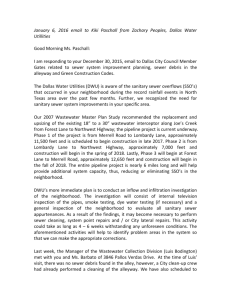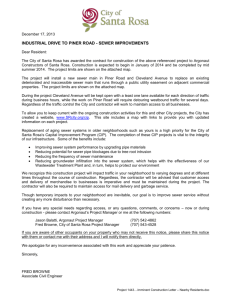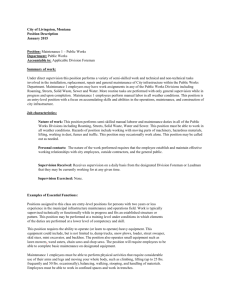Report for Transportation and Public Works
advertisement
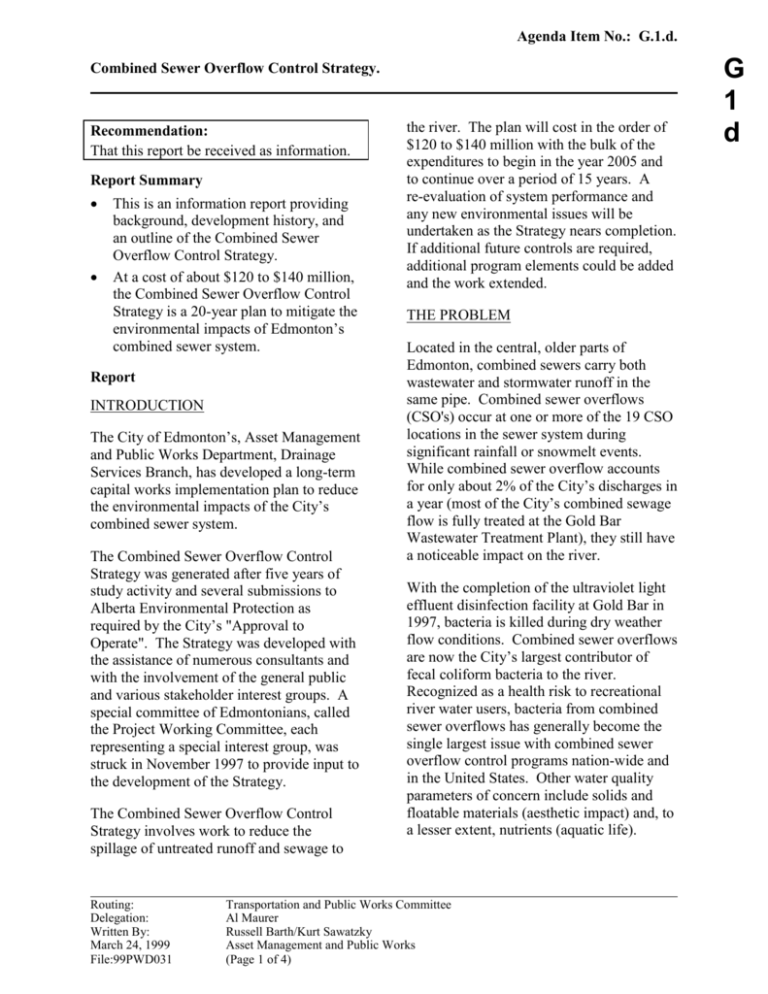
Agenda Item No.: G.1.d. Combined Sewer Overflow Control Strategy. ` Recommendation: That this report be received as information. Report Summary This is an information report providing background, development history, and an outline of the Combined Sewer Overflow Control Strategy. At a cost of about $120 to $140 million, the Combined Sewer Overflow Control Strategy is a 20-year plan to mitigate the environmental impacts of Edmonton’s combined sewer system. Report INTRODUCTION The City of Edmonton’s, Asset Management and Public Works Department, Drainage Services Branch, has developed a long-term capital works implementation plan to reduce the environmental impacts of the City’s combined sewer system. The Combined Sewer Overflow Control Strategy was generated after five years of study activity and several submissions to Alberta Environmental Protection as required by the City’s "Approval to Operate". The Strategy was developed with the assistance of numerous consultants and with the involvement of the general public and various stakeholder interest groups. A special committee of Edmontonians, called the Project Working Committee, each representing a special interest group, was struck in November 1997 to provide input to the development of the Strategy. The Combined Sewer Overflow Control Strategy involves work to reduce the spillage of untreated runoff and sewage to Routing: Delegation: Written By: March 24, 1999 File:99PWD031 the river. The plan will cost in the order of $120 to $140 million with the bulk of the expenditures to begin in the year 2005 and to continue over a period of 15 years. A re-evaluation of system performance and any new environmental issues will be undertaken as the Strategy nears completion. If additional future controls are required, additional program elements could be added and the work extended. THE PROBLEM Located in the central, older parts of Edmonton, combined sewers carry both wastewater and stormwater runoff in the same pipe. Combined sewer overflows (CSO's) occur at one or more of the 19 CSO locations in the sewer system during significant rainfall or snowmelt events. While combined sewer overflow accounts for only about 2% of the City’s discharges in a year (most of the City’s combined sewage flow is fully treated at the Gold Bar Wastewater Treatment Plant), they still have a noticeable impact on the river. With the completion of the ultraviolet light effluent disinfection facility at Gold Bar in 1997, bacteria is killed during dry weather flow conditions. Combined sewer overflows are now the City’s largest contributor of fecal coliform bacteria to the river. Recognized as a health risk to recreational river water users, bacteria from combined sewer overflows has generally become the single largest issue with combined sewer overflow control programs nation-wide and in the United States. Other water quality parameters of concern include solids and floatable materials (aesthetic impact) and, to a lesser extent, nutrients (aquatic life). Transportation and Public Works Committee Al Maurer Russell Barth/Kurt Sawatzky Asset Management and Public Works (Page 1 of 4) G 1 d Combined Sewer Overflow Control Strategy THE STRATEGY Phase A identifies the components being recommended. Strategy Components Phase B, which could proceed after Phase A, consists of various system storage elements which are considered not as cost-beneficial as the Phase A elements. Near the completion of Phase A, a comprehensive Strategy review would be conducted to evaluate the merits of proceeding with Phase B. The Strategy is comprised of the following components: Early Action Control Plan Involves low cost ways to better utilize the existing sewer system. Gold Bar Plant Upgrades Involves upgrading the plant’s capacity to provide enhanced primary treatment of wet weather flows. Strategy Benefits The volume of combined sewer overflow captured in the sewer system can be used as a proxy of environmental benefit. The average annual capture and treatment of wet weather flows in the sewer system will rise in: Phase A, from 56% to 86% capture, and Phase B, from 86% to 90% capture. Tunnel Conveyance and Storage Upgrade combined sewer system conveyance and storage capacity will bring more flow to the plant during and after wet weather events. Opportunistic Sewer System Separation Opportunities to separate the combined sewers into sanitary and storm sewers arise when the infrastructure in older neighbourhoods is rehabilitated. The location of plan components is shown on Attachment 1. More detailed information can be obtained through the “Towards A Cleaner River” website or other sources listed at the end of this report. Implementation Approach A two-phased approach is planned for implementation. Phase A, comprised of the Early Action Control Plan, treatment plant upgrades, and a number of sewer system upgrades, will cost between $120 to $140 million, and is tentatively scheduled between 1999 and 2020 (Attachment 2). Reduction in the frequency of combined sewer overflows can be used as a proxy of aesthetic benefit. The average annual combined sewer overflow occurrences will reduce in: Phase A, from 89 to 46 occurrences, and Phase B, from 46 to 30 occurrences. STRATEGY DEVELOPMENT The development of the Strategy to control combined sewer overflows has been a five year process. It has taken over $2.5 million and about 40 study assignments to develop the Strategy. Numerous technical workshops and Value Engineering sessions brought forth the development of 64 control options, which were refined and evaluated until the recommended plan was arrived at. (Page 2 of 4) Combined Sewer Overflow Control Strategy A large scale public outreach and stakeholder involvement campaign was conducted called ‘Towards A Cleaner River’. Over 15,000 Edmontonians were reached in 1997, 30,000 in 1998, and 30,000 have already been reached in 1999. In addition to exhibiting at public events, numerous stakeholder workshops and public open houses were conducted. A significant contribution to the development of the Strategy was provided by the Project Working Committee, comprised of eleven members of the public, each representing a stakeholder interest group. The Project Working Committee has provided key feedback to the Strategy development process. LEVEL OF SUPPORT Edmontonian's opinions of the Strategy were sought through the following venues: questionnaires at two public open house events, questionnaires within two issues of the River Talk newsletter (distributed to over 400 people), questionnaires and general feedback obtained at numerous public events (e.g. home shows, etc.), feedback from briefings given to a number of stakeholder interest groups (e.g. Environmental Advisory Committee, etc.), and feedback from the Project Working Committee. Most responses received were favourable to the Strategy. Most people indicated that they are offended by the notion of raw sewage entering the river, and most are willing to accept the high cost of control. While the range of views on the Project Working Committee is diverse, most support the components within Phase A of the Strategy. Some members feel that both Phase A and B should be implemented, while others question the merits of the Phase B components when they compare the costs against benefits that could be achieved. The Project Working Committee is currently preparing a report which will summarize its perspectives on their involvement in the development of Edmonton’s Combined Sewer Overflow Control Strategy, and its level of support for the Strategy. Alberta Environmental Protection has received submissions required in the City's "Approval-to-Operate", including the “Long Term Control Plan” report that outlined the alternative plans under development on June 1, 1998. Alberta Environmental Protection has responded favourably to pursuing plans that are cost-effective and provide significant environmental benefits. Budget / Financial Implications The inclusion of the Combined Sewer Overflow Control Strategy in Drainage Services’ 20-year financial planning horizon has not resulted in a need to adjust customer rate charges beyond the changes which were previously planned. This is likely due to the following factors: Early Action Control Plan activities were included in previous capital budgetting; 20-year planning had previously included some Combined Sewer Overflow Control Strategy funding; the period for large expenditures on the Plan is purposely planned for post 2005 when the large scale environmental expenditures on tertiary treatment at the Gold Bar plant will be complete; and (Page 3 of 4) Combined Sewer Overflow Control Strategy implementation of the Plan is to be distributed over a long period (about 15 years) to minimize funding impacts. Legal Implications The City of Edmonton is legally responsible to develop and implement a plan to control combined sewer overflows, as outlined in the City's provincial "Approval-to-Operate" (No. 95-MUN-117): “3.1.8 The approval holder shall develop: (a) a comprehensive Combined Sewer Overflow Control Strategy and a Wastewater Collection System Management Strategy to minimize the impact of discharges on the North Saskatchewan River, and a plan for implementing these strategies by June 1, 2000”. “9.5.1 The approval holder shall submit… (c) reports on the Combined Sewer Overflow Control Strategy… (iv) June 1, 1999 for Phase V: Implementation”. on-line Internet version anticipated for April 9, 1999. 2. CSO Long Term Control Plan, UMA Engineering Ltd., April, 1999. 3. Combined Sewer Overflow Control Strategy Long Term Control Plan, City of Edmonton, June 1, 1998 (report to province). 4. A bibliography listing over 40 supporting reports, and any one of the individual reports. Others Approving this Report Law Branch Background Information Attached 1. Combined Sewer Overflow Control Strategy – Location of Plan Components. 2. Combined Sewer Overflow Control Strategy – Recommended Implementation Schedule. Background Information Available on Request 1. Towards A Cleaner River Website developmental version: www.hotspur.com/river (Page 4 of 4)

